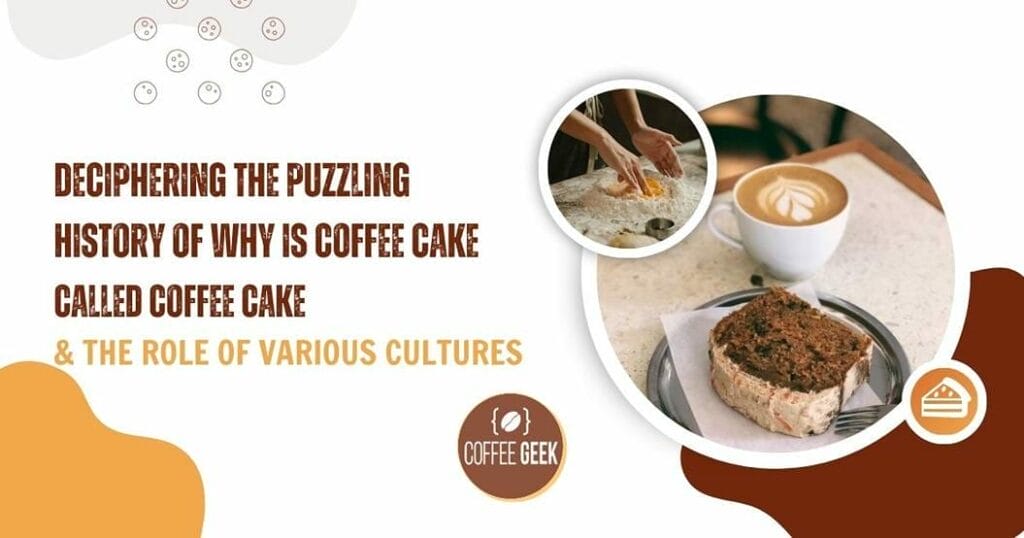Often found alongside a cup of coffee, answering the question of why is coffee cake called coffee cake can be quite puzzling.
This sweet treat, primarily baked with love and serves as the perfect companion during tea time, carries the name coffee without having the beverage as an ingredient.
From the German roots to the American twist on the traditional recipe, follow along as we delve deep into the history of coffee cake.
- A Taste of the Origins: How the Coffee Cake was Born and its Evolution in Central Europe?
- A Deep-Dive into the German Coffee Cake and its Unique Characteristics
- Understanding the Journey and Transformation of Coffee Cake in America
- Demystifying why Coffee Cake is Called so Regardless of the Absence of Coffee Ingredient
- Discovering the Various Types and Variations of Coffee Cakes Around the World
- FAQ
A Taste of the Origins: How the Coffee Cake was Born and its Evolution in Central Europe?
The coffee cake, as we know it today, has its beginnings primarily rooted in Central Europe during the 17th century.
However, this type of cake was originally akin to sweet bread rather than being the sponge cake we’ve come to know as coffee cakes.
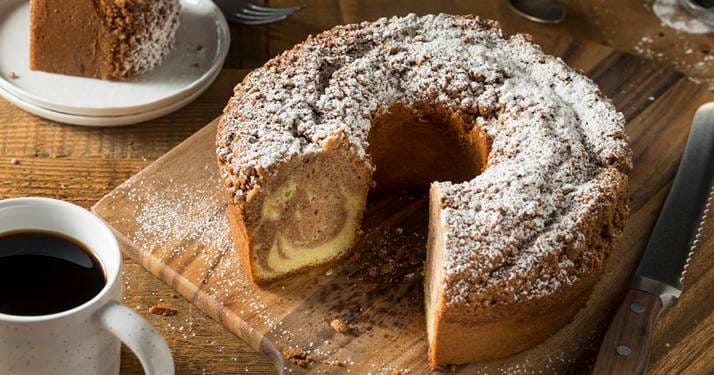
What’s the 17th Century Role in Shaping the Coffee Cake’s History?
The 17th century played a transformative role in the history of coffee cake.
At a time when coffee first became kind of commonplace, bakers in Central Europe started to create sweet, bread-like treats to be enjoyed alongside coffee, shaping the links between coffee and cake that persist to this day.
From where did the German Influence on Coffee Cake Originate?
The German impact on coffee cake can’t be overstated. It’s thought that the German coffee cake most often refers to a yeast cake topped with streusel.

This style is a nod to the traditional way European bakers would pile on sugar, flour, and butter to their yeasty doughs before putting them in the oven.
How did Dutch Traditions Shape the Coffee Cake’s Development?
Likewise, Dutch traditions played an influential role in the development of coffee cakes.
They introduced the use of a more cake-like batter, the addition of spices like cinnamon, as well as fruits and nuts to the recipe, and developed the layered character of this baked good.
A Deep-Dive into the German Coffee Cake and its Unique Characteristics
Understanding German coffee cake gives insight towards why the infamous Bundt shaped pastry is so beloved.
The German coffee cake signifies a blend of traditional baking practices and creative ingredients that evoke a unique, homely feel.
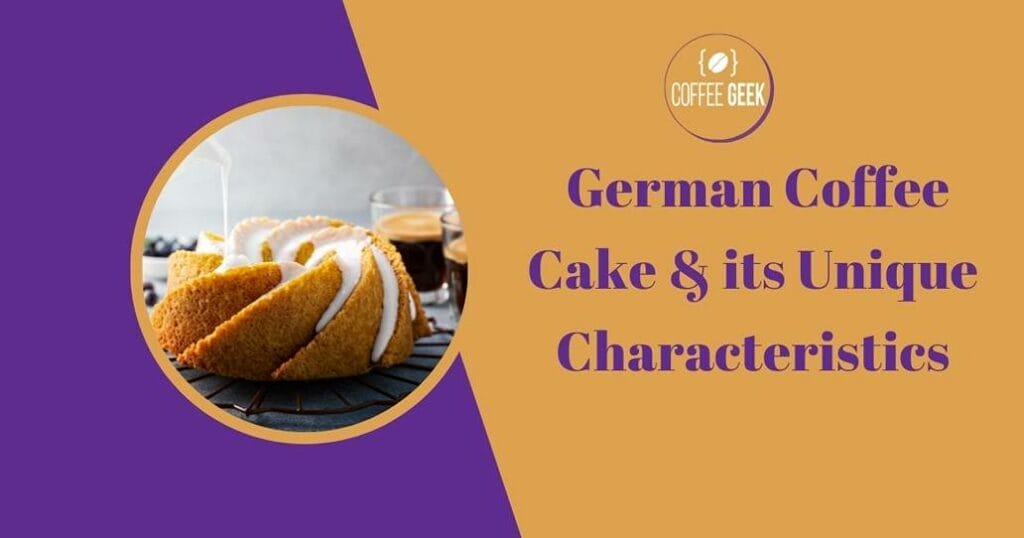
Streusel: A Key Element of German Coffee Cake
Centric to the German coffee cake is Streusel– a topping made from butter, flour, and sugar. This crumbly top brings texture to the normally soft coffee cake, providing a delectable contrast with every bite.
The Streusel topping often includes nuts, further enhancing its appeal.
Decoding the use of Yeast in German Coffee Cake
Yeast is another key element that sets German coffee cake apart.
The use of yeast instead of baking soda or baking powder gives the cake its distinctive, bread-like texture, which makes it perfect for enjoying coffee during breakfast or brunch.

It’s a bit denser than say a sponge cake, but if you’re lucky enough to taste one fresh out of the oven, it’s a sublime experience.
Facts about the Traditional German Coffee Cake Baking Process
Baking a traditional German coffee cake involves a meticulous process.
Mixing the ingredients correctly, allowing time for the yeast to rise, and achieving the perfect streusel topping all contribute to creating a slice of culinary heritage in every cake.
Understanding the Journey and Transformation of Coffee Cake in America
American coffee cake carries a story of adaptation and reinvention.
It managed to maintain the essence of its European origin while introducing new elements that have become defining characteristics of its recipe.
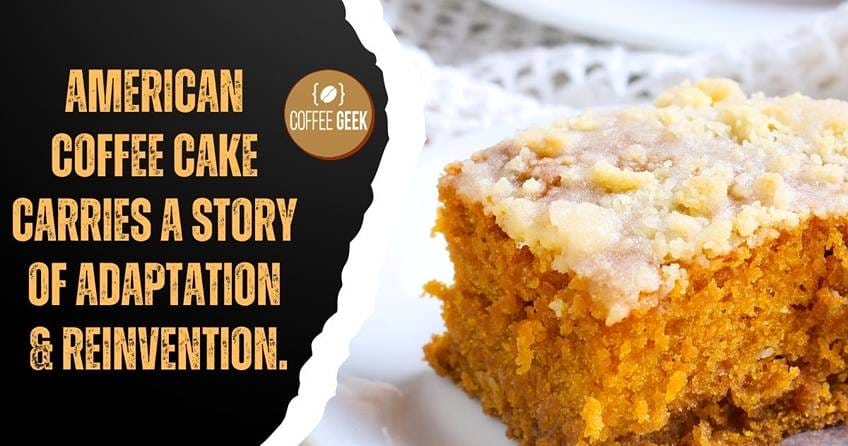
How did Coffee Cake Become Commonplace in North America?
In the 19th century, coffee cake became a real star in North America.
It was enjoyed as a quick bread-like cake for afternoon tea-time, and soon came to be associated with Sunday mornings, social gatherings, and holiday festivities.
How did Baking Soda Revolutionize the American Coffee Cake?
The introduction of baking soda in the 19th century revolutionized the American coffee cake.
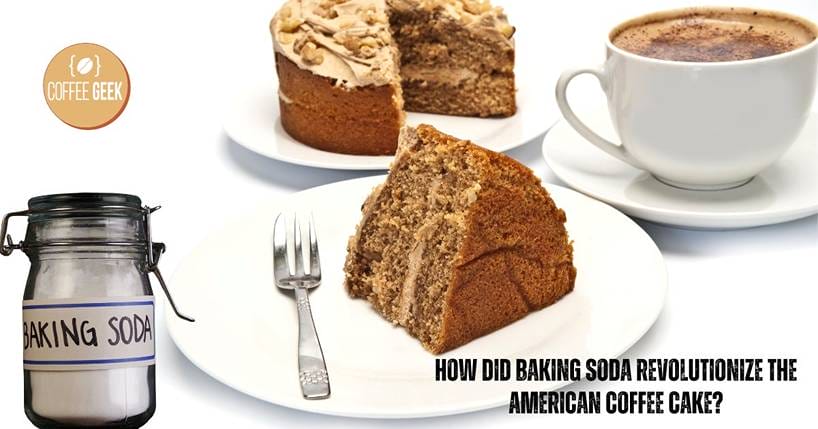
With baking soda, bakers could now create lighter and fluffier cakes without the need for yeast.
It sped up the baking process and changed the texture of the finished product, making it closer to the cake that we’re accustomed to today.
The Role of the Addition of Sour Cream in the American Coffee Cake’s Popularity
Another major American innovation was the addition of sour cream to the cake batter.
The tangy flavor compliments the sweetness of the cake and the cinnamon streusel topping, and it served to keep the cake moist and rich.
| Reason | Explanation |
|---|---|
| Historical Association | The term “coffee cake” has historical roots, dating back to a time when cakes were commonly served with coffee during social gatherings or coffee breaks. |
| Complementary Pairing | Coffee cake is designed to complement coffee, offering a sweet and often crumbly texture that pairs well with the strong and bitter flavors of coffee. |
| Traditional Accompaniment | Coffee cake has become a traditional accompaniment to coffee, often served during breakfast or brunch, enhancing the overall coffee-drinking experience. |
| Shared Consumption Rituals | The practice of enjoying coffee and cake together has led to the association of the term “coffee cake,” as these items are frequently consumed in tandem. |
| Versatility in Flavors | Coffee cakes come in various flavors, such as cinnamon, nuts, or fruit, which can complement the diverse taste profiles of different coffee varieties. |
| Cultural Evolution | Over time, the association between coffee and cake has become deeply ingrained in various cultures, contributing to the widespread use of the term “coffee cake.” |
| Marketing and Naming Conventions | The term “coffee cake” may have been popularized through marketing efforts, as it effectively communicates the intended pairing with coffee, making it a recognizable and marketable product. |
| Social Customs and Traditions | Social customs and traditions, such as afternoon tea or coffee gatherings, have played a role in solidifying the association of certain baked goods, like coffee cake, with coffee consumption. |
| Consumer Expectations | The name “coffee cake” sets certain expectations for consumers, indicating a cake specifically suited for pairing with coffee, influencing their choice when selecting baked goods. |
Demystifying why Coffee Cake is Called so Regardless of the Absence of Coffee Ingredient
The term ‘coffee cake’ might seem confusing to most of us, as coffee is typically not an ingredient.
The name stems from the cake’s traditional purpose – to be enjoyed with a cup of brewed coffee.
How a Misnomer? Why is Coffee Cake Called Coffee Cake?
Despite the initial thought that a ‘coffee cake’ might contain coffee in its recipe, the term emphasizes the tradition of eating this delicately sweet treat alongside a cup of coffee.

The name alone indicates its intended pairing rather than what it’s made with.
The Association Between Drinking Coffee and Eating Coffee Cake
Similar to the association of cookies with milk, the idea of sipping coffee while nibbling on a fluffy, streusel-topped coffee cake has become deeply rooted in both European and American cultures.
It’s the simplicity of enjoying coffee and cake together that led to this beloved baked good’s moniker.
Might Think! Importance of Coffee as a Pairing, not an Ingredient
The term ‘coffee cake’ tells us less about the makeup of the cake itself and more about the cake’s cultural context.
The warm, robust flavor of coffee serves as the perfect companion for the sweet and soft cake, enhancing every bite and every sip. Instead of being flavored with coffee, the cake is savored with it.
Discovering the Various Types and Variations of Coffee Cakes Around the World
Despite the standard recipe, coffee cake has branched out, as various cultures have adapted and added their own creative spins to it.
From the Nut-Streusel topping of some versions to the savory cheese bun, coffee cakes come in an endless array of delightful variants.
Decoding the Nut-Streusel Topping: An American Twist on the Classic Coffee Cake
The American version of coffee cake often includes a layer of Nut-Streusel topping, adding a crunchy texture to the overall soft and moist interior of the cake.
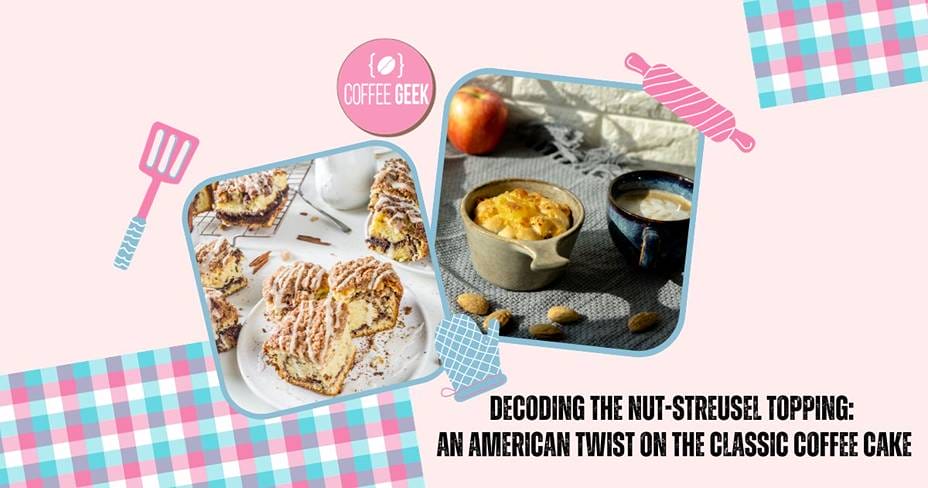
The streusel gives a pleasant surprise to the palate with each bite, offering a fine balance between the soft cake and the crispy topping.
Bundt Cakes: How Cakes Went from Being a Bread to a Pastry?
The introduction of the Bundt pans was instrumental in the transformation of the coffee cake from being bread-based to a centerpiece pastry.
Bundt cakes, often drizzled with glaze or dusted with icing sugar, bring an elegant aesthetic charm that evolved coffee cakes from a quick snack to a star of dessert tables.
The Use of Cinnamon Glaze: Making Coffee Cakes a Sweet Treat
The evolution of the coffee cake now includes an added hint of cinnamon glaze, making coffee cakes a truly sweet treat.
This extra detail elevates the overall taste experience, and it’s common to find variations that even incorporate elements like cream cheese, chocolate cake, or a sweet icing glaze to make coffee cakes an indulgent delight.
Whether it’s German or American, with yeast or baking soda, served as a quick snack or a festive dessert, one thing is certain – the history of coffee cake is as rich and delightful as the cake itself.
So, the next time you take a bite of a coffee cake, remember that you are in fact nibbling on a centuries-old tradition crafted to be savored alongside coffee.
FAQ
What is the history of coffee cake?
The concept of coffee cake has its roots back in the late 19th century.
The first coffee cake was a type that was typically consumed alongside a cup of coffee. It is a misconception that coffee cake is made with coffee.
It traditionally refers to any cake that’s flavored and served alongside a cup of coffee.
Coffee cake even in many countries doesn’t contain coffee but has rich, buttery ingredients like brown sugar, most commonly associated with a crumb topping.
Is coffee cake made with coffee?
Contrary to what one might think, coffee cakes are usually not made with coffee.
They are called “coffee cakes” because they are often served with coffee, not because they contain coffee. A rare except coffee cake could be a coffee-flavored coffee cake.
What are different types of coffee cake?
Coffee cake comes in many variations and is infinitely customizable! Commonly, you’ll find ones swirled with fruit, featuring a luscious crumb topping, or even a buttery Danish-style coffee cake in a bakery.
All can be excellent companions to a cup of coffee. It’s really up to the chef’s creativity and the judge’s taste!
Do all types of coffee cakes have a crumb topping?
No, not all coffee cakes have a crumb topping. However, this is a popular feature of many American versions, which often incorporate a mixture of flour, brown sugar, and butter.
Other types may not have this feature, but have other delightful elements like swirls of fruit or generous layers of icing.
So why is coffee cake even called ‘coffee cake’ if there is no coffee in it?
While it may seem strange, the name ‘coffee cake’ doesn’t actually refer to the ingredients. Instead, it refers to the tradition of serving these moist, sweet cakes alongside a cup of coffee.
This tradition became widespread among immigrant communities, particularly those of Danish descent in the US.
Is coffee cake a widespread tradition?
Absolutely! Coffee cake has a long-standing tradition in many countries, the United States and Denmark being particularly well-known.
The delicious pairing of cake and coffee has been first mentioned in texts from countries as diverse as Austria (think Vienna!) and Germany (kuchen or cake).
Today, this tasty treat is a staple in bakeries all over the world.
Can I find a coffee cake recipe that contains coffee?
Yes, although it’s not traditional, some coffee cake recipes do use actual coffee in them.
Adding coffee to the recipe can give the cake a caffeinated kick, to balance the sweetness. So, indeed, there’s no rule against stirring some espresso into the mix!
What is a popular tradition involving coffee and cake?
A classic tradition involving coffee and cake is the Danish concept of “kaffe og kage,” quite literally meaning “coffee and cake”. This combo is often enjoyed in the late afternoon or early evening.
It’s so ingrained into Danish culture that many folks may ask, “What’s coffee without something sweet to accompany it?”
Does eating coffee cake give one the same effects as consuming coffee?
No, unless the coffee cake is made with caffeine-rich coffee, it won’t have the same effect as drinking a cup of coffee.
Traditional coffee cake is called such because it’s often served alongside coffee, not because it has the same effects.
Can I make coffee cake with different toppings?
Absolutely! Coffee cake is infinitely customizable.
While a common topping is the crumbly, buttery mixture of brown sugar and flour, feel free to try nuts, different types of fruit swirled into the batter or perhaps a nice cream cheese icing top.
Why not experiment a bit? A coffee cake is pretty forgiving and open to interpretation by the chef!

